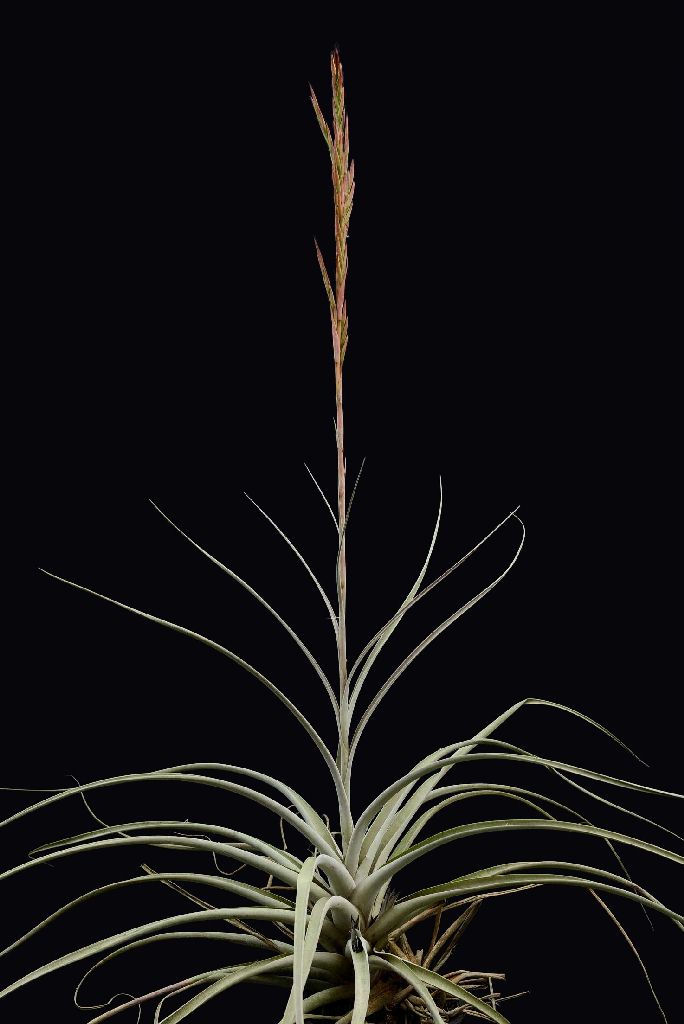
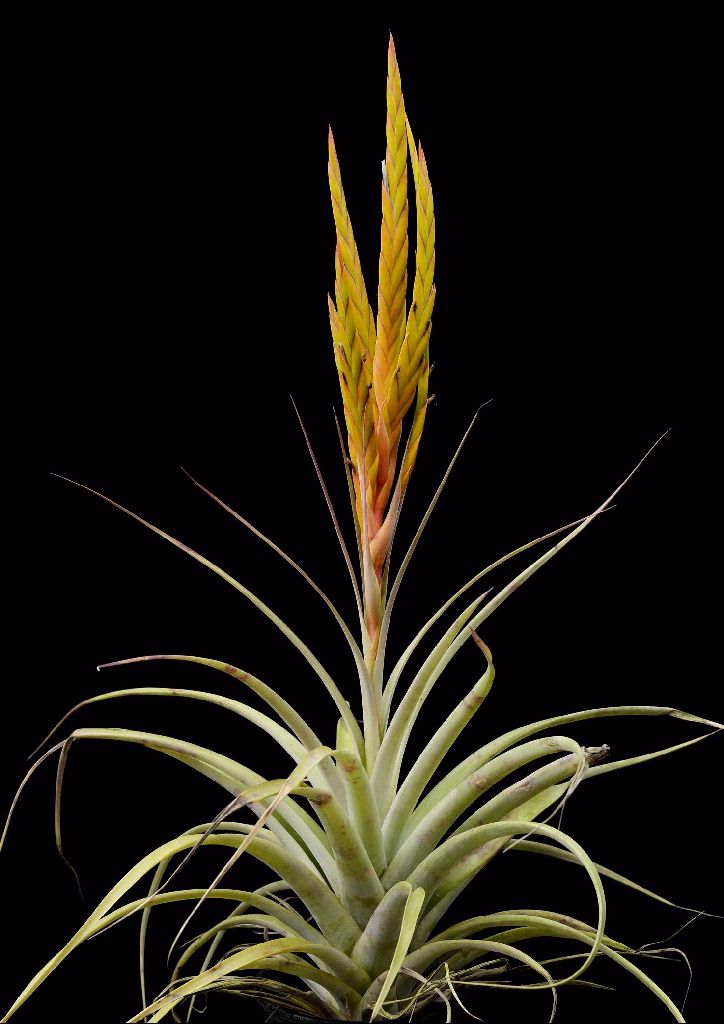
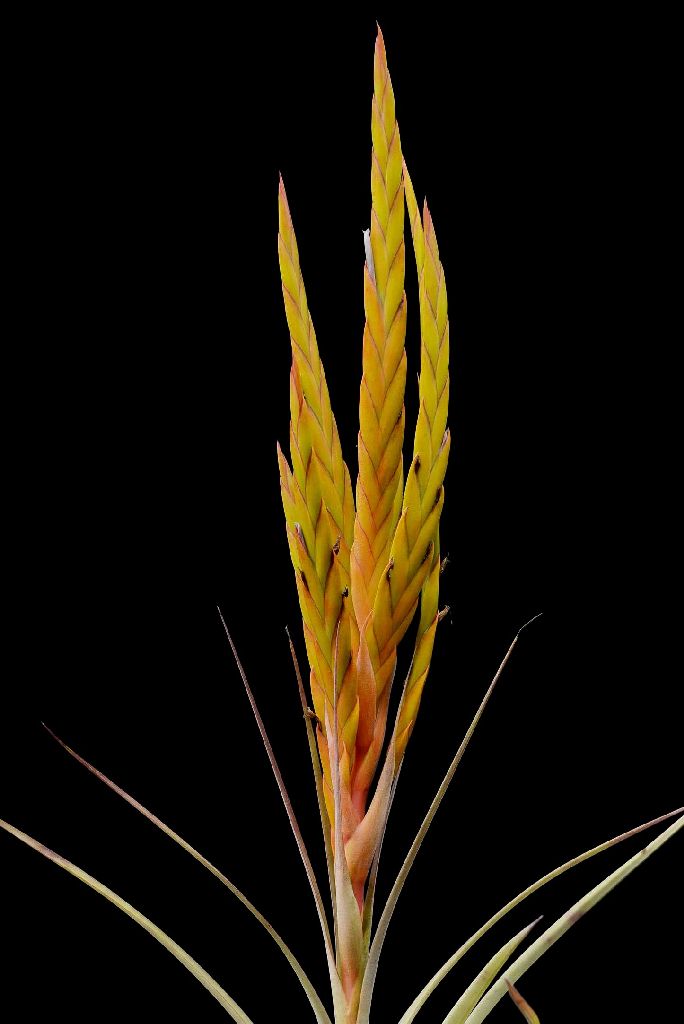
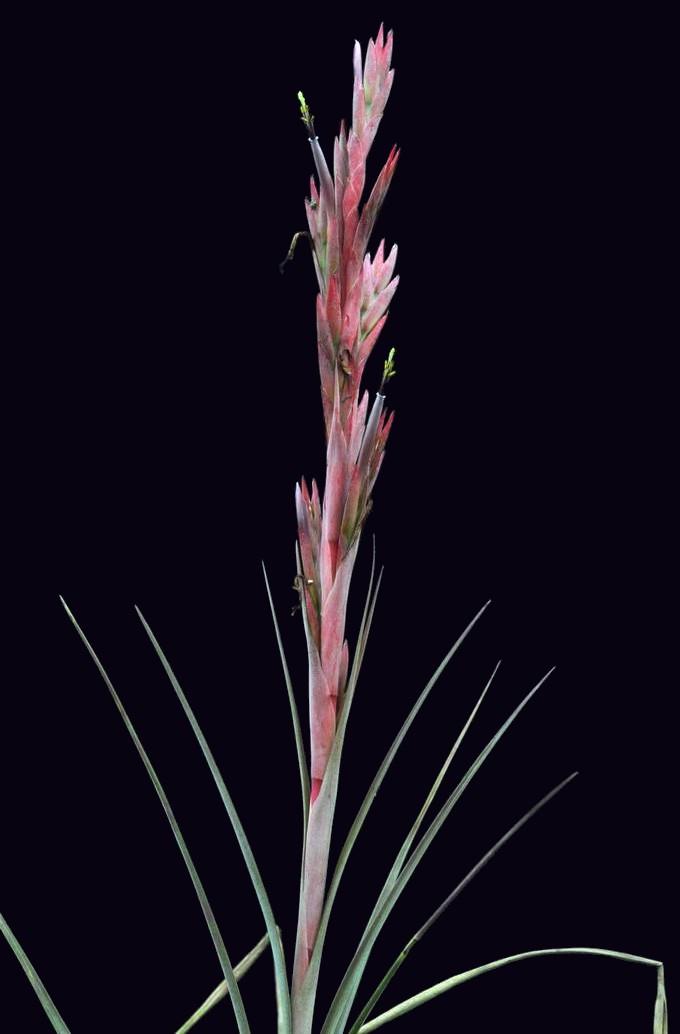
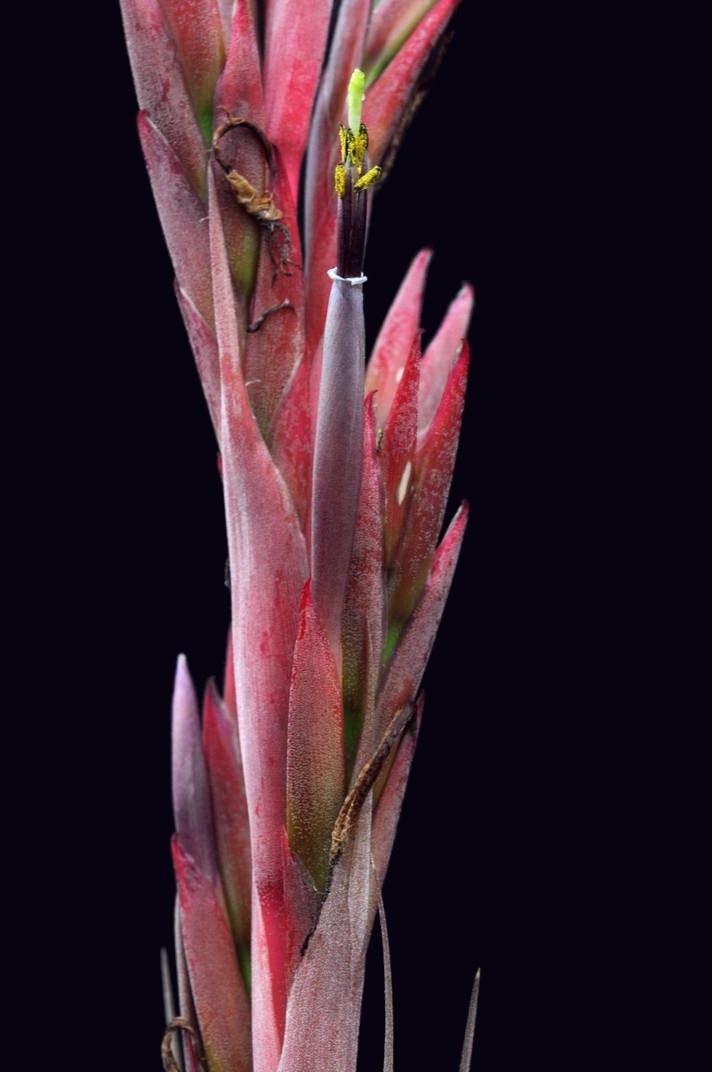
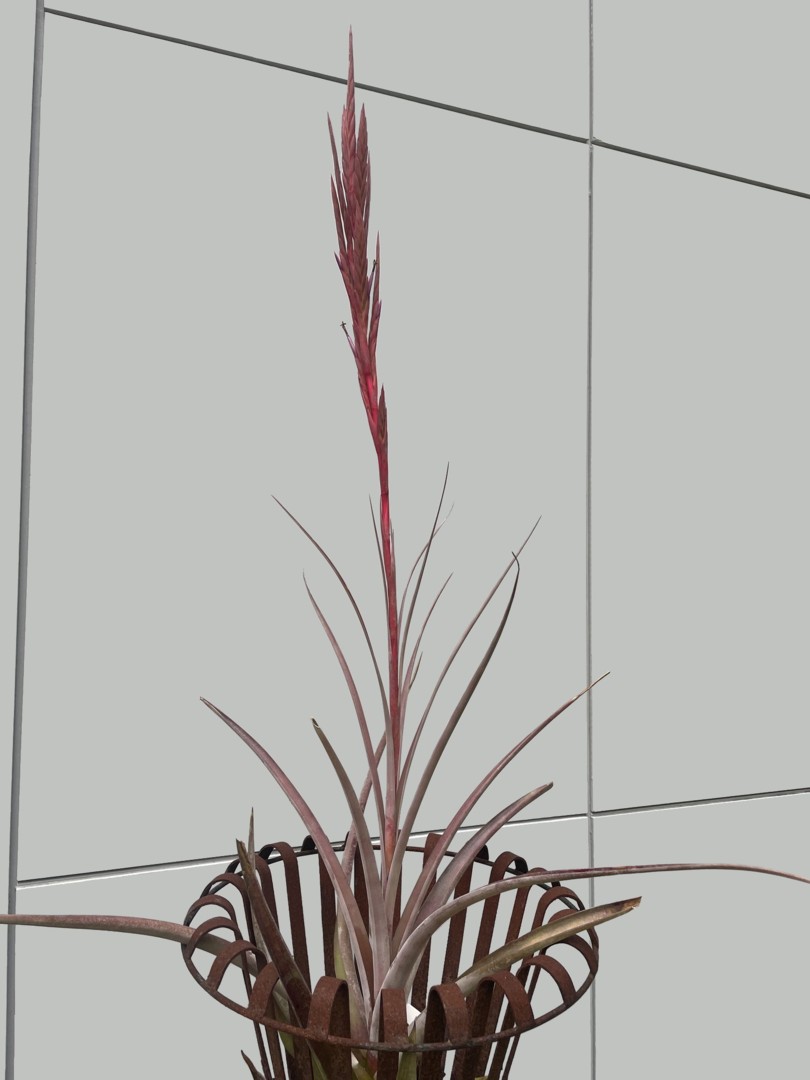
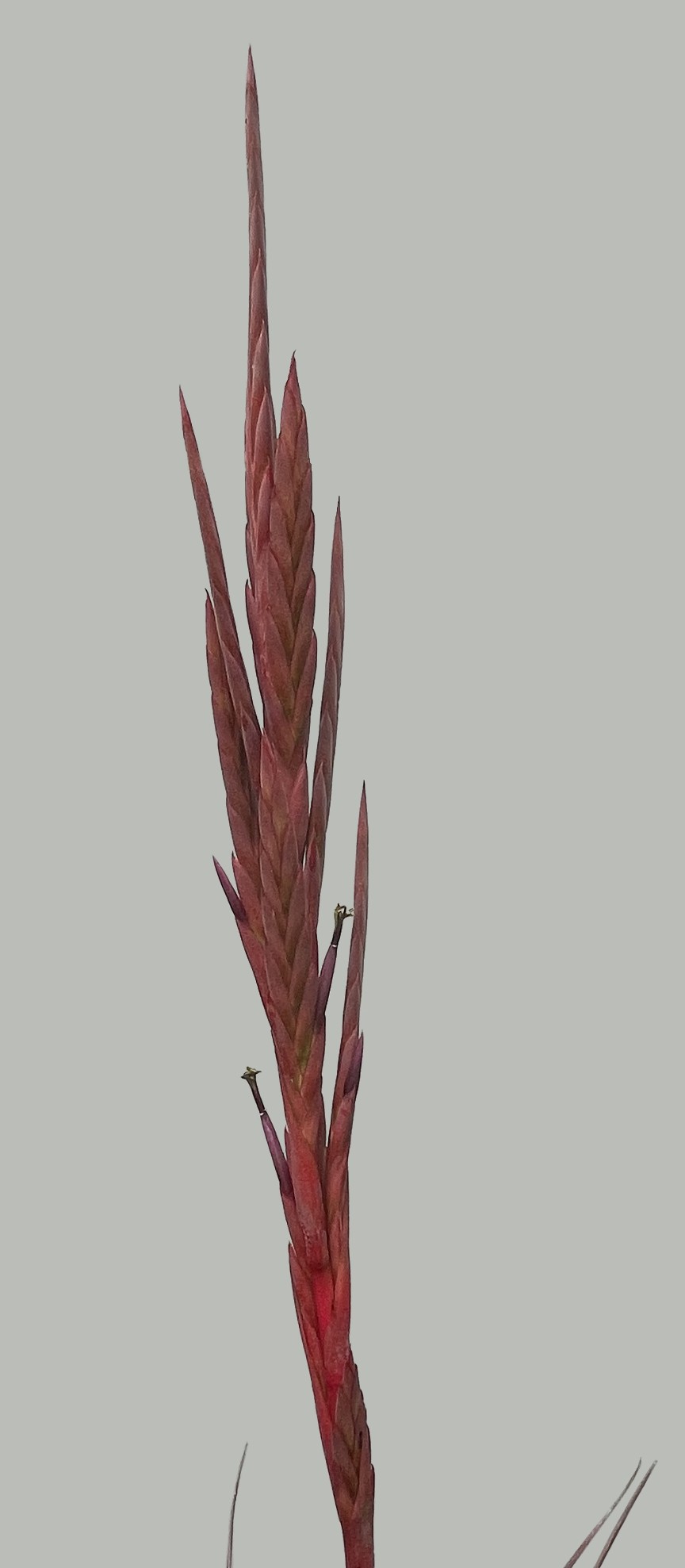
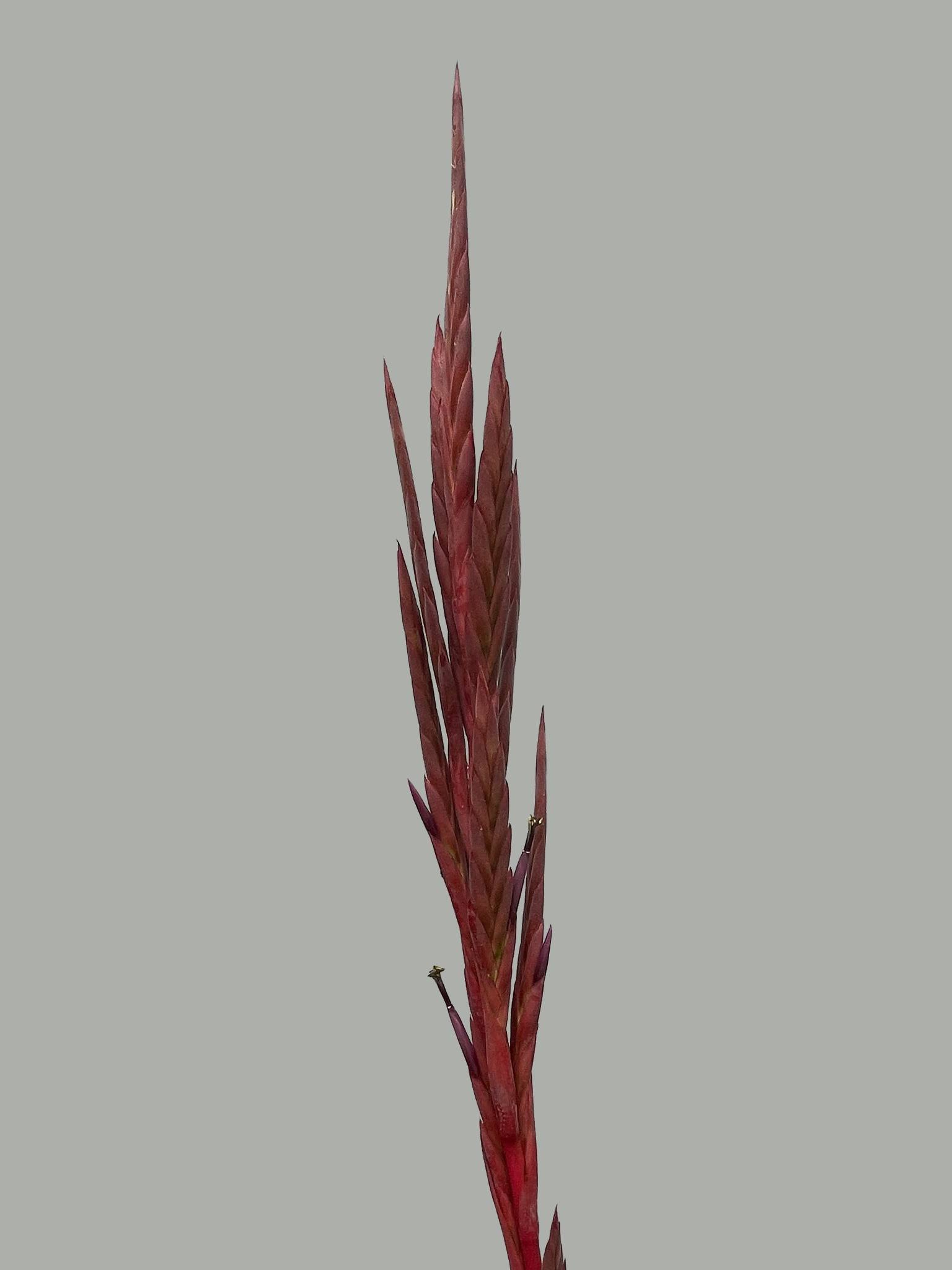
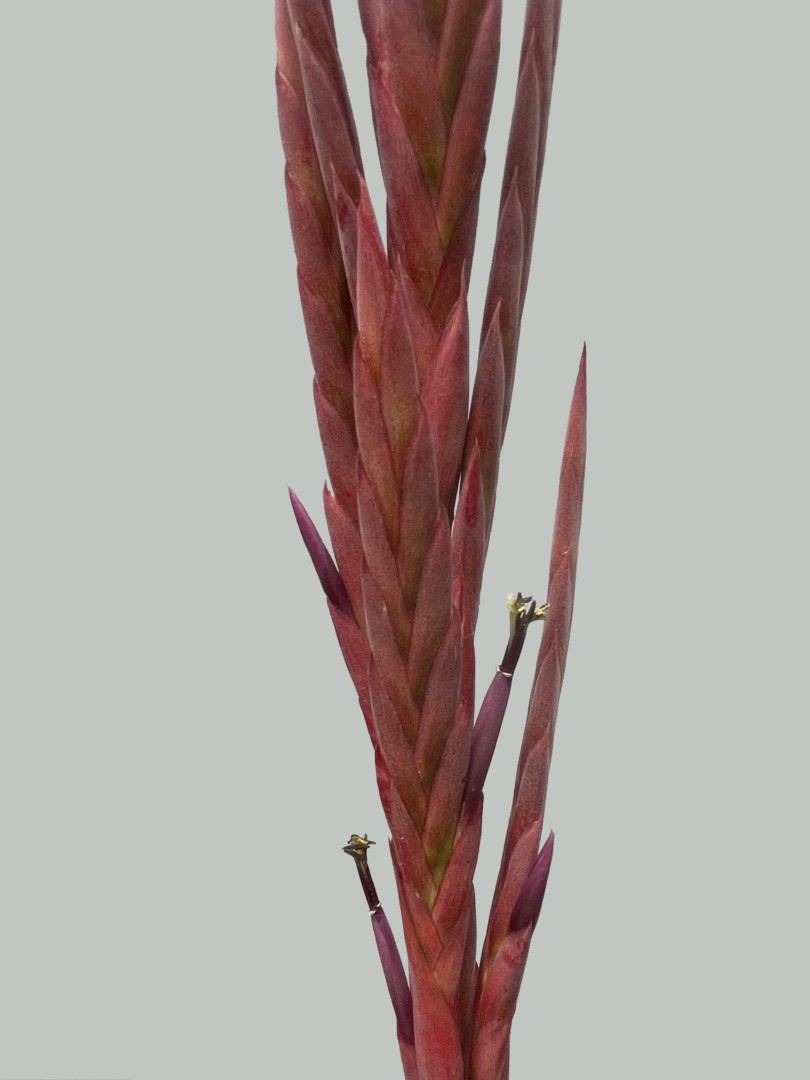
Plant mostly terrestrial, growing singly or in groups, short stemmed, forming a lax rosette, to 80 cm high, to 90 cm diam., flowering to 2m high.
Leaves to 90 cm long, hard leathery, stiff, dense grey appressed lepidote.
Sheath 12 – 20 cm long, 6 – 8 cm wide, triangular–elliptic, a little distinct from the blade, both sides light brown, dense small grey lepidote.
Blade to 70 cm long, ca 3 cm wide next to sheath, narrow–triangular, caudate, the edges bent inwards, green, shining greyish white because of dense grey scales (inside stronger), erect to spreading or bent outwards.
Scape erect, to 40 cm long, to 15 mm diam., flexuous, glabrous, hard and woody, Internodes ca. 10 cm.
Scape bracts ca. 10 cm long elliptic sheath, densely imbricate, firmly enclosing the scape which is hardly visible, the blade similar to the inner rosette leaves, however of a pink colour, to 35 cm long, narrow–triangular, linear–acuminate, bent outwards.
Inflorescence to 80cm long, to 6cm wide, with 5–13 spikes, erect, almost parallel to the main axis, compound.
Main axis 6–8mm diam., strong, flexuous, nerved, Internodes for bottom spikes 6mm, the upper ones to 3mm.
Primary bracts sheaths of lower spikes to 13cm long, as long as the stem of the spike, erect and firmly enclosing the stem, long acuminate, the upper ones gradually shorter and short tipped, becoming similar to the floral bracts.
Spike 5–20cm long, 1–1.2cm wide, almost complanate, lancelike, acuminate, 2–9cm long stem which has to 6 sterile supplementary and small bracts, towards the top the primary bracts are adjacent to the floral bracts, the flat side of the spike joined to the main axis, the floral bracts densely imbricate, making the main axis hardly visible, with 5–20 sessile flowers, Internodes 1–2cm.
Flower bracts 3–4.1cm long, 1–1.5cm wide, elliptic, acuminate, thin leathery, not keeled or the tip weakly keeled, inside strongly nerved, the base small punctulate lepidote, outside red, a little lepidote, almost glabrous, shining, nerved.
Sepal 2.4–2.7 (3.1)cm long, 7–9mm wide, elliptic-acuminate, yellow green with red tip, thin leathery with hyaline edges, weakly nerved, sub free (the front joined for 2mm with the ovary and the posterior for 3–6mm), the posterior strong and thickly keeled and the front one with a thick middle.
Petal 4.4–6.5cm long, tongue shaped acuminate with a rounded depression, the upper portion to 10mm wide, narrowing to 4mm wide at base, forming an erect tube with the tips bent a little outwards, dirty light lilac, the base white.
Stamens exceeds the flower.
Filament 5.2–7cm long, arranged in 2 unequally long series, the upper portion 1mm wide, flat oval, violet, narrowing to ribbonlike at base, repeatedly twisted and entangled, white.
Anther 3–3.5mm long, 1mm wide, ellpitic, brown, joined versatile 1/4 from the base.
Pollen citron yellow.
Style 4.5–6cm long, yellow green, top centimetre violet.
Stigma 5–6mm long, 2–3mm wide. Lobes long and narrow, erect, spreading post floral, not twisted, a little papillose, light green (Type1 Brown and Gilmartin).
Ovary 5–6mm high, 2.5-3mm wide, conical, light green.
Type locality Mexico, border of Jalisco and Colima, near Cihuatlan on Rio Marabasco, 10m leg K&R Ehlers EM 910501 23/2/1991 Holotype WU.
Differs from T. roseoscapa in
Stem short.
Leaves more leathery, much longer.
Scape bracts longer, leathery with a sharp acuminate tip.
Spikes much longer (to 20cm as against 3–10cm)
Floral bracts almost ecarinate, sub glabrous.
Sepals wider, glabrous.
Petals longer, pale violet not yellowish green.
Previously in March 1990 Gunther Noller had collected a smaller, not yet flowering plant at the same location. The same Tillandsia was collected by Jurgen Lautner, Gottingen, in 1992 and 1994.
The plant usually grows terrestrial (seldom on cactus), in dry scrub with Cereus, Cephalocereus, a cushion-forming Mammillaria, Barkeria dorotheae, T. marabascoensis, T. ionantha, T. makoyana, and T. caput-medusae.
The plant gets its name from our friend Gunther Noller, from Bischmisheim near Saarbrucken, who discovered this Tillandsia in the Spring 1990. Gunther Noller makes field studies in the area of tillandsias, orchids and cactus, on many trips to south and Central America. We ourselves have traveled Mexico, Ecuador and Peru with him.
The plant differs from T. roseoscapa Matuda in the following points:
Plant only forms short stems.
Leaf internodes larger, leaves more hard leathery, more than twice as long, forming a lax rosette.
Scape flexuous, cape bracts much longer, hard leathery with a sharp tip,
Spikes much longer, (to 20cm instead of 3-10cm), however more narrow and lanceolate linear, long stemmed.
Floral bracts not keeled, almost glabrous, sepals wider, glabrous, petals longer, bright violet instead of yellow green.
The plant is not only conspicuous through its size. It is not like any other Mexican Tillandsia and is therefore hard to classify. The closest seems to be T. roseoscapa Matuda however this is, so far, only known from southern Mexico in highlands over 1000m. In contrast to the description by Matuda or Rauh, where the stem is said to be short, the front part of the plant often forms in the course of years a stem many meters long, whose rear end rots, continuing to grow over the rocks. When flowering it forms an approximately 80-120cm high rosette.
Near Zapotitlan close to Tehuacan, Estdo. Puebla, we saw plants to 10m long with rotten stems (EM 911803). In the state of Oaxaca near Coatlan the plants were smaller and formed dense clumps, 25cm high plants flowering already. In contrast to the statement by Rauh all of our material showed the filaments with the anthers protruding far from the flower tube.
Examined material of T. roseoscapa: Mexico, Estdo. Oaxaca, Huajuapan de Leon, main road after Oaxaca close to Tamazulapan; EM 78 s. n. leg. Klaus & Renate Ehlers, March 1978; Estdo. Puebla. Zapotitlan, EM 911803, 3. March 1991, leg. K. R. Ehlers; Estdo. Puebla, Canada Morelos, March 1992 leg. Gunther Noller s. n.; Estdo. Oaxaca, St., Maria Coatlan, EM 931505, 18. 3. 93 leg. K. & R. Ehlers.
Already in Die Bromelie 2/91, we reported on our trip "10 years of field examinations on the Mexican Pacific Coast" which reminded us of this unusual new Tillandsia. We had looked for the location on our trip in February 1991 on the basis of advice from Gunther Noller. Already on the basis of the photographs of smaller plants, we knew what unnamed plant we were looking for. Gunther had brought us two plants and reported that he had been unable to find a single flowering plant. We now had great luck, in the following year to find several flowering examples of the species, unfortunately these proved to be much too large for transportation. Not one of the examples could be fitted in our large suitcase. Two inflorescences, that only some weeks before had been in full flower were stowed in the suitcase diagonally and packed two extra, almost flowering size plants. The suitcase was full! From now on we were limited in our collections because we had no more space for large plants!
We hoped that one of the larger plants would flower in our collection soon. They received the best place in the sunniest position under the roof of our glasshouse where they made themselves comfortable and grew well.
In the Spring of 1993 they were so large that both plants developed an inflorescence. But our curiosity was put to a long test: only in July were the plants large enough and we finally saw flowering. In the autumn, the mother plants produced three strong offsets each.
In March 1994, we went to Cihuatlan again, and although I had high fever and was feeling awful from the antibiotics that I had taken, we drove to the location. We arrived at 10 o'clock in the morning with the temperature at 35C degrees in the shade, and humidity at 46%.
I pulled on my thickest jeans and a long sleeved shirt and struggled through the thorn bushes up the mountain. There was a reasonable path because the local people hunted iguanas there. In our last trip we saw two boys, who watched us warily because they did not know who we were, soon killed two animals. On the coast, today hundreds of living and dead iguanas are offered for sale. Especially cruel is how the mouths of living animals are secured so they will not bite. – no animal welfare organisations here.
Despite the path, I was burning hot as I silently moved through the narrow thorny path. My heart thumped alarmingly. Only the romantic outlook of the Rio Marabasco, far below, winding through the misty heat haze makes the toil seem worthwhile. I found not a single plant and not even a plant of the new T. marabascoensis, that had been found there by Jurgen Lautner. Strangely, from the really large plants that we saw there in 1991 in full flower, should have produced offsets. But precisely at the same area I found not a single one. Quite distressed I returned to the car only to find the temperature was 4C degrees higher. The plant is clearly not abundant. Jurgen Lautner had luck however in 1994 when he found some plants again.